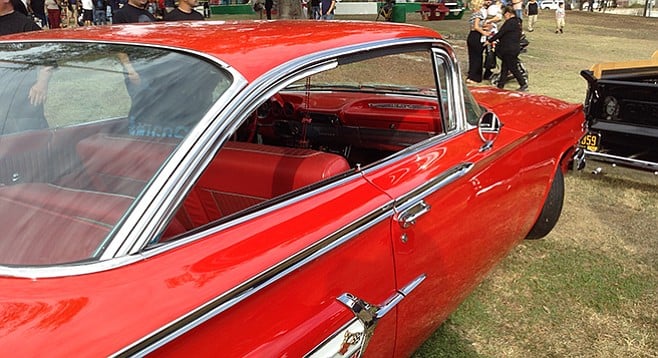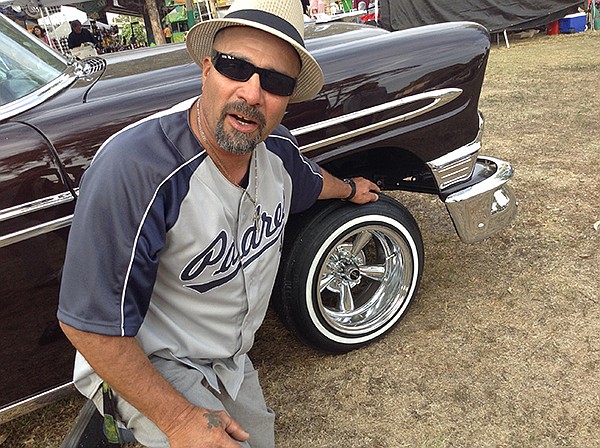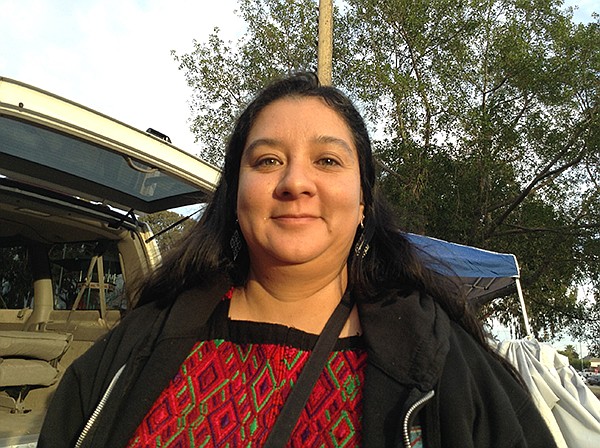 Facebook
Facebook
 X
X
 Instagram
Instagram
 TikTok
TikTok
 Youtube
Youtube

“You see this? This is how it should be,” says David Sanchez III.
He’s leaning over and pointing to the exaggerated solid chrome wheel rim of a black 1956 Chevrolet Bel Air that’s sitting on its rear haunches, nose in the air. It has the welded chain-link steering wheel, 520-s tires with the one-inch whitewall, and these solid chrome rims with a half-moon hub.
We’re at Chicano Park, here in the Barrio, at the end of the 48th annual Chicano Park Day, and guys are standing round, talking their specialized low rider talk.

“You see, this is how they were in my dad’s time,” David’s saying. “The best rims! Supreme, Cragar, Rocket. The baby moons and half-moons. Then, spoke rims started coming in. Alliance. Star Wire. Me, I don’t care for spokes. My dad was part of the Tijuana scene. United Browns Car Club. He had a ’49 Chevy Deluxe. Chop-top. Paid me 50 cents to polish it every weekend. And he was the first to go into pearl paint. He brought it right up here in 1974 and won Best in Show! From TJ? Those San Diego guys were shocked.”
Me, I’m in love with another car, with its pearlescent red paint, the perfect chrome sweep of its stanchion-free side windows, the full spare tire in the scarlet and chrome shell behind the winged trunk. And yes, those four ruby-tipped hydraulic sprout levers on the driver’s side that will make this baby tip up, tip down, go high, go low.
Problem is, this 1960 Chevy Impala belongs to Shorty. Shorty transformed it. Shorty had the magic touch. Supported by his buddies in the Amigos Car Club. People say some of the machines here are worth 40, 60, 100 grand, with their combination of antiqueness, technical wizardry, artistry, and flare.

But it’s not just cars that keep you here. Lizeth Duenas is selling jewelry to raise money for bees to pollinate the endangered peyote cactus down in San Luis Potosí, so it can deliver relief for different illnesses, even though, up here, it’s recognized only as a hallucinogen. A guy named Sergio is loudly predicting World War Three, quoting a Hopi named Ahkima. A gal in full Aztec regalia is waiting for her mom to start a dance demo.
It takes a moment to remember that almost 50 years ago, there was no Chicano Park. In 1970, authorities had just demolished over 5000 Barrio Logan homes, to make way for Interstate 5 and the Coronado Bay Bridge. People were feeling disrespected. So they formed human chains around bulldozers, held a 12-day occupation, and won the right to a park.
As I leave, Sergio, the voice of the Hopi prophet, is speaking in Nahuatl. “‘Ta zo camahti!’ ‘The sun will shine upon us again!’”


“You see this? This is how it should be,” says David Sanchez III.
He’s leaning over and pointing to the exaggerated solid chrome wheel rim of a black 1956 Chevrolet Bel Air that’s sitting on its rear haunches, nose in the air. It has the welded chain-link steering wheel, 520-s tires with the one-inch whitewall, and these solid chrome rims with a half-moon hub.
We’re at Chicano Park, here in the Barrio, at the end of the 48th annual Chicano Park Day, and guys are standing round, talking their specialized low rider talk.

“You see, this is how they were in my dad’s time,” David’s saying. “The best rims! Supreme, Cragar, Rocket. The baby moons and half-moons. Then, spoke rims started coming in. Alliance. Star Wire. Me, I don’t care for spokes. My dad was part of the Tijuana scene. United Browns Car Club. He had a ’49 Chevy Deluxe. Chop-top. Paid me 50 cents to polish it every weekend. And he was the first to go into pearl paint. He brought it right up here in 1974 and won Best in Show! From TJ? Those San Diego guys were shocked.”
Me, I’m in love with another car, with its pearlescent red paint, the perfect chrome sweep of its stanchion-free side windows, the full spare tire in the scarlet and chrome shell behind the winged trunk. And yes, those four ruby-tipped hydraulic sprout levers on the driver’s side that will make this baby tip up, tip down, go high, go low.
Problem is, this 1960 Chevy Impala belongs to Shorty. Shorty transformed it. Shorty had the magic touch. Supported by his buddies in the Amigos Car Club. People say some of the machines here are worth 40, 60, 100 grand, with their combination of antiqueness, technical wizardry, artistry, and flare.

But it’s not just cars that keep you here. Lizeth Duenas is selling jewelry to raise money for bees to pollinate the endangered peyote cactus down in San Luis Potosí, so it can deliver relief for different illnesses, even though, up here, it’s recognized only as a hallucinogen. A guy named Sergio is loudly predicting World War Three, quoting a Hopi named Ahkima. A gal in full Aztec regalia is waiting for her mom to start a dance demo.
It takes a moment to remember that almost 50 years ago, there was no Chicano Park. In 1970, authorities had just demolished over 5000 Barrio Logan homes, to make way for Interstate 5 and the Coronado Bay Bridge. People were feeling disrespected. So they formed human chains around bulldozers, held a 12-day occupation, and won the right to a park.
As I leave, Sergio, the voice of the Hopi prophet, is speaking in Nahuatl. “‘Ta zo camahti!’ ‘The sun will shine upon us again!’”
Comments